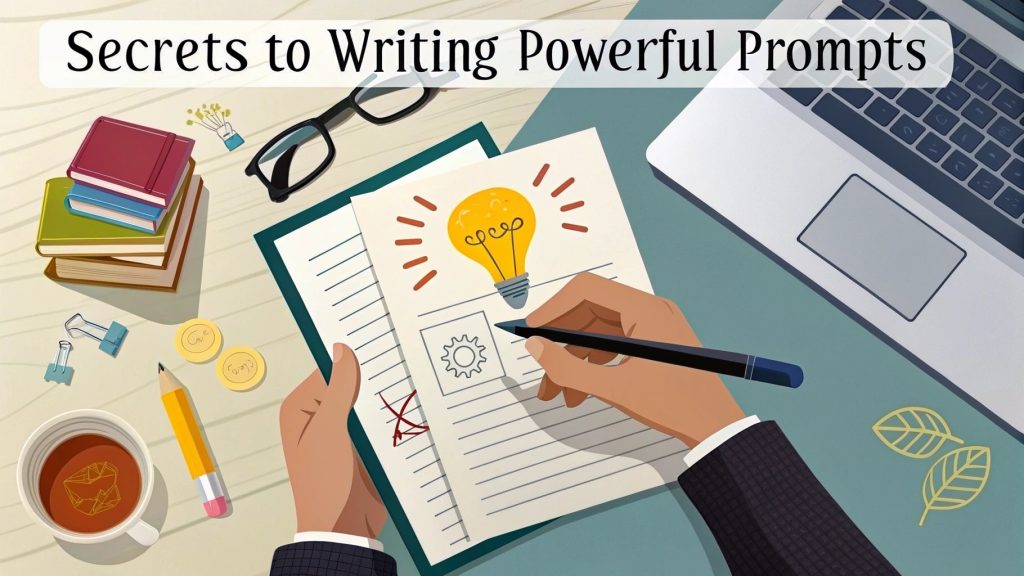Discover the secret to writing a powerful prompt. Get smarter AI outputs with these expert techniques.
Why do some AI prompts produce incredible results while others fall flat? The difference often comes down to how they’re written. In this article, we’ll break down what makes a prompt truly powerful — and how a few smart tweaks can turn generic input into gold-standard output. If you’re ready to level up your AI game, read on.
Why Prompt Quality Matters More Than Ever
AI tools have become incredibly advanced, but they still rely on one thing to perform well: your prompt. Whether you’re writing with ChatGPT or creating visuals with Midjourney, the results are only as good as the instruction you give. That’s why mastering prompt writing is quickly becoming a must-have skill. A powerful prompt doesn’t just tell the AI what to do—it guides it like a compass.
The Key Ingredients of a Powerful Prompt
Clarity: Remove All Guesswork
Vague prompts lead to vague outputs. Instead of saying “Write something about leadership,” say “Write a 400-word article on empathetic leadership for new managers, in a conversational tone.” The more specific you are about the task, the better the AI can deliver results you’ll actually use.
Intent: Be Goal-Oriented from the Start
Why are you using the AI? Are you brainstorming, drafting, summarizing, or explaining? A strong prompt makes that goal clear. For example: “Summarize this 5-paragraph email into a professional one-liner for LinkedIn.” The AI needs direction — and that direction starts with intent.
Context: Feed the AI Useful Background
AI performs best when it knows what you know. If you’re asking for product descriptions, include the product name, target customer, and tone. If you’re generating headlines, say who they’re for and what you’re selling. Prompt: “Write 3 engaging headlines for an eco-friendly water bottle aimed at Gen Z.” Context = precision.
Examples: Weak vs. Powerful Prompts
Writing Prompts for Content Creation
- Weak: Write a blog about time management.
- Powerful: Write a 600-word blog post offering 5 time-saving tips for remote workers, with a friendly and motivational tone.
The second prompt gives the AI direction, structure, and style. That’s the difference between filler and publish-ready content.
Visual Prompts for AI Art Tools
- Weak: Draw a city at night.
- Powerful: Create a futuristic cyberpunk city at night with glowing neon signs, fog, and reflections on wet streets, digital art style.
Visual AIs depend heavily on details. Style, lighting, and color choices all matter—and powerful prompts bring those elements together.
Common Mistakes That Weaken Your Prompts
Vague Language and Missing Roles
Don’t assume the AI knows your voice or audience. Instead of saying “Write me an intro,” try: “Act as a college professor and write a short, engaging introduction to the history of spaceflight for a classroom handout.” Assigning a role improves tone, vocabulary, and perspective.
Asking for Too Much in One Go
If you overload the AI with multiple tasks in a single prompt, you’ll get scattered results. It’s better to break it up: first ask for an outline, then expand section by section. Think of AI like a collaborator — you work better together when you keep things focused.
How to Practice Writing Better Prompts
Use Templates, Then Adapt Them
Starting with tested structures helps. Templates like “Act as [role]. Write [type of content] about [topic] in [tone] for [audience]” are simple but powerful. Over time, you’ll build your own versions based on what works best for your tasks.
Start Small and Iterate
You don’t need to perfect your prompt on the first try. Ask the AI to refine its own output: “Rewrite that in a more casual tone” or “Give me a list version instead.” Treat prompts as part of a conversation, not a one-shot command.
Final Thoughts: Prompts Are the New Literacy
Knowing how to write a powerful prompt is the key to getting the most out of AI. It’s not just about wording—it’s about strategy, clarity, and intent. In a world where AI is your co-creator, your ability to guide it is everything. Start small, be specific, and practice often. The better your prompts, the smarter your AI becomes.
Writing a powerful prompt isn’t magic — it’s a skill. With clarity, intent, and the right structure, you can turn any AI tool into a reliable partner. Start experimenting, keep refining, and you’ll be amazed at how much more value you can unlock. In the age of AI, the prompt is your most powerful tool.

